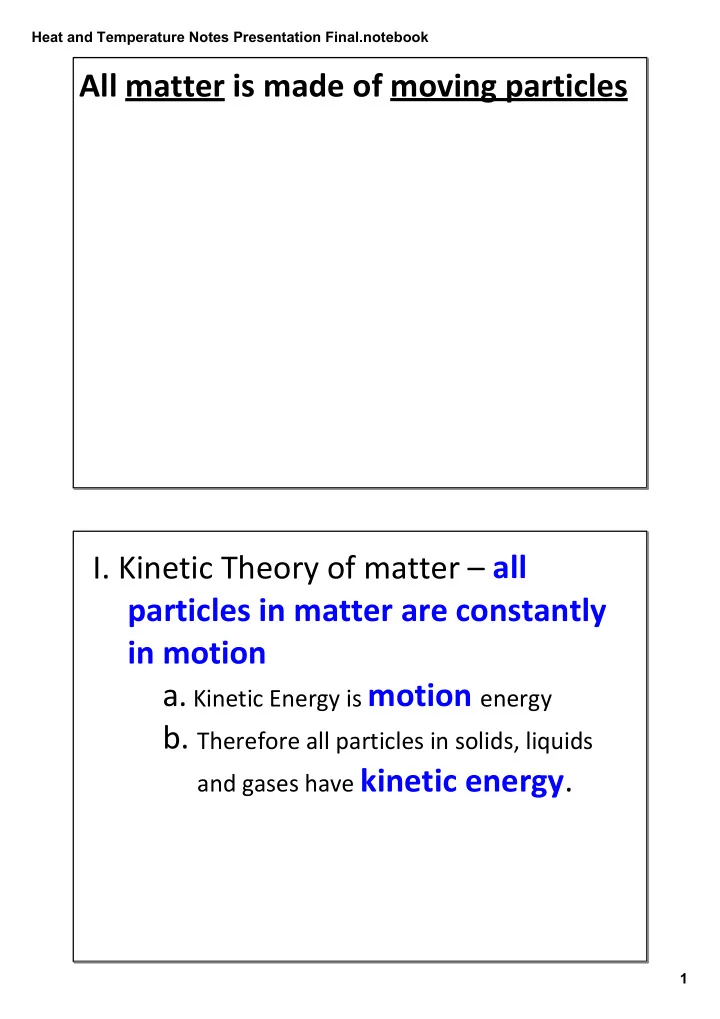

Heat and Temperature Notes Presentation Final.notebook All matter is made of moving particles I. Kinetic Theory of matter – all particles in matter are constantly in motion a. Kinetic Energy is motion energy b. Therefore all particles in solids, liquids and gases have kinetic energy . 1
Heat and Temperature Notes Presentation Final.notebook C. Temperature is a measurement of the average kinetic energy of all the particles in a substance. D.The faster the particles are moving the more kinetic energy they have, and increase the temperature . E. All particles in a substance are moving but not at the same speed and the speed can change . (phase chages) 2
Heat and Temperature Notes Presentation Final.notebook Temperature can be measured I. 3 temperature scales: Celsius ( 0 C), Fahrenheit ( 0 F), and Kelvin (K) II. Absolute zero ‐ 0 K , and ‐273.15 0 C , is the temperature where there is no particle movement. III. Thermometers measure temperature : Alcohol expands when heated (liquid moves up the tube as it expands) and contracts when cooled (liquid moves down the tube as it contracts). 3
Heat and Temperature Notes Presentation Final.notebook Heat is DIFFERENT from temperature I.Heat, temperature, and thermal energy are similar but not the same. II. Temperature : average kinetic energy of particles in a substance III. Heat : flow of energy from a warmer substance to a cooler substance. When energy is transferred the thermal energy of both substances changes IV. Thermal Energy : the total kinetic energy of particles in a substance. 4
Heat and Temperature Notes Presentation Final.notebook Measuring Heat I. The most common units of heat measurement are the CALORIE and the JOULE . II. A calorie is the amount of ENERGY NEEDED TO RAISE THE TEMPERATURE OF 1 GRAM OF WATER 1 0 C III. A joule is the STANDARD SCIENTIFIC UNIT FOR MEASURING ENERGY . 5
Heat and Temperature Notes Presentation Final.notebook Some Substances change temperature more easily than others I. SPECIFIC HEAT : the amount of energy that is required for 1gram of a substance to increase in temperature by 1 0 C. II. The more MASS an object has, more ENERGY is required to produce an increase in temperature (get hotter). 6
Heat and Temperature Notes Presentation Final.notebook III. The more MASS an object has, more ENERGY must be released to produce a decrease in temperature (get cooler). Section 4.3: The Transfer of Energy as Heat can be Controlled 7
Heat and Temperature Notes Presentation Final.notebook Energy moves as heat in 3 ways I. Conduction: ENERGY TRANSFERRED THROUGH PHYSICAL CONTACT (OBJECTS MUST BE TOUCHING). Particles of a warmer object collide with particles of a cooler object and some of their energy is transferred to the cooler object. 8
Heat and Temperature Notes Presentation Final.notebook II. CONVECTION : a. Only occurs in LIQUIDS and GASES b. Caused by differences in densities, which are caused by differences in temperatures. i. Hotter=less dense Colder = more dense C. LESS dense liquids and gasses will FLOAT while MORE dense liquids and gasses SINK to the bottom; creating a convection current. 9
Heat and Temperature Notes Presentation Final.notebook D. Cycles of convection cause the CURRENTS in the ocean, and WINDS in the atmosphere. Sea breeze… Land breeze…. III. Radiation: ENERGY THAT TRAVELS AS ELECTROMAGNETIC WAVES 10
Heat and Temperature Notes Presentation Final.notebook A. All objects radiate at least a small amount of energy B. Electromagnetic waves: visible light, x‐rays, microwaves, radio waves, gamma rays, ultra violet rays. C. Unlike conduction or convection, radiation can move through empty space (the universe, or a vacuum). 11
Heat and Temperature Notes Presentation Final.notebook 12
Heat and Temperature Notes Presentation Final.notebook Different materials are used to control the transfer of energy . I. CONDCUTORS are objects that transfer energy easily. For example: metals (copper, iron, magnesium etc..) II. INSULATORS are objects that do not transfer energy easily. For example: wood, paper, plastic foam, anything with lots of trapped air 13
Recommend
More recommend